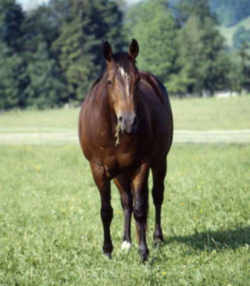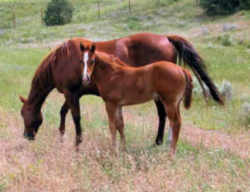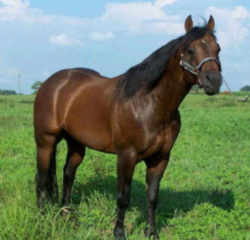
Texas Symbols
Texas State Horse
American Quarter Horse

(E. f. caballus)
Adopted on June 19, 2009.
Texas State Representative Larry Philips introduced House Concurrent Resolution No. 53 on February 18, 2009. With a letter of endorsement from the American Quarter Horse Association, Logan testified before the House Committee of Culture, Recreation and Tourism in March. By the end of the day on May 26, 2009, House Concurrent Resolution No. 53 had been approved by the Texas House of Representatives and approved by the Senate. The American quarter horse became the official state horse of Texas when Governor Rick Perry signed House Concurrent Resolution No. 53 on June 19, 2009.
Texas State Horse: American Quarter Horse
 Just what is an American Quarter Horse?
Just what is an American Quarter Horse?
If you have ever seen a horse in one of rodeo's timed events, been along for work on a ranch or watched a Western on the big or small screen, 9
times out of 10 you have witnessed an American Quarter Horse.
These heavily muscled, compact horses could run a short distance over a straightaway faster than any other horse, and the fastest were called Celebrated
American Quarter Running Horses by English colonists in the 1600s. In 1940 a registry was formed to preserve the breed which officially became
the American Quarter Horse.
The American Quarter Horse Association (AQHA) was formed in Amarillo, Texas, in 1940 and Quarter Horses began to be registered, first in Texas and Oklahoma. The breed soon spread in popularity around the country.
There are 17 recognized colors of American Quarter Horses including the most prominent color of sorrel (brownish red). The others are bay, black,
brown, buckskin, chestnut, dun, red dun, gray, grullo, palomino, red roan, blue roan, bay roan, perlino and cremello.
It's interesting to note that the quarter-mile is still the most popular distance for racing American Quarter Horses, and the best blaze the 440 yards
in 21 seconds or less.
History and Origins:
Quarter Horses are a mixture of Arabian, Spanish, and English bred horses. There are eleven foundation Quarter Horse bloodlines. These eleven families are the ancestors of all Quarter Horses around the world. Although the breed or type has been in existence since the 1600s the American Quarter Horse Registry began in 1940. The introduction of Thoroughbred bloodlines has created two distinct types of Quarter Horses. "Appendix Quarter Horses"tend to be leaner and leggier.
The characteristics of American Quarter Horse

The American Quarter Horse has a muscular neck, deep chest, sloping shoulders, and a relatively small head with wide eyes and pointed ears (which are always alert). Its legs are muscular and firm; however, the horse's feet have been described as too small for the animal's size. Because of this, the Quarter Horse - standing between 14.3 and 16 hands high - is said to look rather chunky. (A hand is a common unit of measurement for horses that is equal to four inches.)
The most common color for the Quarter Horse is sorrel (or chestnut). And although the Appaloosa and Pinto markings are not acceptable for the breed standard, it is quite normal to see white markings on the Quarter Horse's face or legs.
Size:
The Quarter Horse stands with his legs well under him and flat on the ground. Mature Size: Although the Quarter Horse usually weighs between 500 and 600 kilos, he is relatively small by comparison to other breeds. American Quarter Horses range in size from 14 to over 16 hands high.
Uses:
The American Quarter Horse can be seen in virtually every riding discipline and still races a quarter mile at tracks throughout the United States. They are equally at home under saddle or in harness where they're steady dispositions often make them the ideal beginner or family horse.
Color and Markings:
There are 16 recognized colors of the American Quarter Horse. The most prominent color is sorrel (brownish red). Other colors include bay, black, brown, buckskin, chestnut, dun, red dun, gray, grullo, palomino, red roan, blue roan, bay roan, perlino and cremello.
Unique Characteristics:
Quarter Horses are quick over short distances, sure footed and agile. They make comfortable mounts for trail riding and are dependable for all day
farm work. The compact muscular silhouette of the foundation type Quarter Horse is unmistakable. With its calm, gentle and steady demeanor they are
the ideal family horse or horse for the beginner rider. Because they have a steady temperment does not mean they are slow to learn however. Many Quarter
Horses have natural 'cow sense', that makes them easy to train for ranch work, or competition such as roping and cutting. Once trained, they need very
little guidance from their rider. They tend to be 'easy keepers' living well off of good pasture or hay.
Texas House Concurrent Resolution No. 53
The American quarter horse became the official state horse of Texas when Governor Rick Perry signed House Concurrent Resolution No. 53 on June 19, 2009.
H.C.R. NO, 53
HOUSE CONCURRENT RESOLUTION
WHEREAS, The history and culture of Texas have been greatly influenced by the celebrated era of cowboys and cattle drives and by the ranching industry,
which continues to be an important component of the Texas economy to this day; the significance of these elements to the state's identity is reflected
in a number of the official symbols that have been recognized by the Texas Legislature, including the designation of the longhorn as the state large
animal and rodeo as the state sport; and
WHEREAS, Perhaps the most iconic symbol of western lore is the horse, and one breed in particular, the American quarter horse, has played a central
role in the story of the Lone Star State; and
WHEREAS, This versatile animal likely arrived in Texas soon after the region was opened to colonization in the 1820s, helping to transform the unsettled
wilderness into a productive land of farms and small towns; quarter horses also proved invaluable to such legendary figures as Sam Houston, whose mount
Copper Bottom was a member of the breed; and
WHEREAS, The America quarter horse first caught the attention of many during the cattle drives of the late 1800s; strong, smart, fast, and tough, the
animal was perfectly suited to the task of carrying cowboys on the long journey from Texas to the railheads of Missouri and Kansas; the drovers called
the prized ponies "steeldusts," a name derived for the well-known American quarter horse racer Steel Dust, who had won a host of victories
in Texas in the mid-1800s and who sired numerous offspring; and
WHEREAS, While widely admired for its achievements on the western frontier, the American quarter horse traces its heritage to and earlier era of U.S.
history; in the colonies of Virginia and North Carolina and South Carolina, the Galloway and hobby breeds from England were mated with Spanish Barb
horses raised by the Chickasaw people; the result was the Celebrated Quarter of a Mile Running Horse," which excelled at short-distance races;
later, Thoroughbred stallions and hardy mustangs of the American West also contributed to the bloodline to produce the horse so beloved by the Texas
cowhands; and
WHEREAS, Today, the Lone Stare State is home to nearly 500,000 American quarter horses that are ow2ned by more than 130,000 Texans, and the breed has
a sizable commercial impact on the state through its prominent role in horse shows, racing, ranching, recreational riding, and other endeavors; and
WHEREAS, This noble animal endears itself to Texans in numerous ways; rodeo athletes rely on its agility and intelligence when competing in roping
and barrel-racing events, and riders of all abilities know it as a gentle and amiable animal that is a faithful companion on the trail; of course,
the quarter horse remains a fixture on the working ranches of Texas, where its hoofbeats still resound across the wide open spaces that were trodden
by its ancestors in the decades past; and
WHEREAS, A uniquely American breed that reflect the historical development of our state and nation, the American quarter horse is a vital part of our
Texas heritage, and it is indeed a most appropriate symbol for the Lone Star State; now, therefore, be it
RESOLVED, That the 81st Legislature of the State of Texas hereby designate the American quarter horse as the official State Horse of Texas.
With a letter of endorsement from the American Quarter Horse Association, Logan testified before the House Committee of Culture, Recreation and Tourism
in March.
By the end of the day on May 26, 2009, House Concurrent Resolution No. 53 had been approved by the Texas House of Representatives and approved by the
Senate.
The American quarter horse became the official state horse of Texas when Governor Rick Perry signed House Concurrent Resolution No. 53 on June 19,
2009.
Texas Law
The American quarter horse was named the official horse of the State of Texas by House Concurrent Resolution and is not, therefore,
listed in the Texas Statutes.
Only a few of Texas' myriad symbols were actually adopted by an act of the legislature and written into the Texas Statutes.
Taxonomic Hierarchy: American Quarter Horse
Kingdom: Animalia
Phylum: Chordata
Class: Mammalia
Order: Perissodactyla
Family: Equidae
Genus: Equus
Species: E. ferus
Subspecies: E. f. caballus







